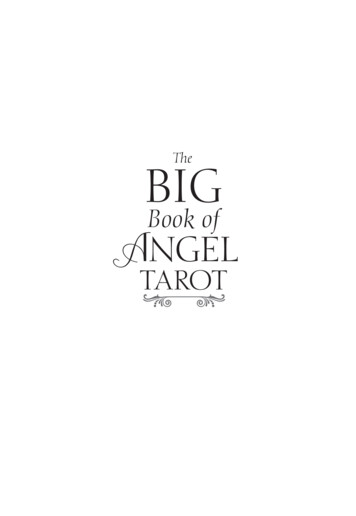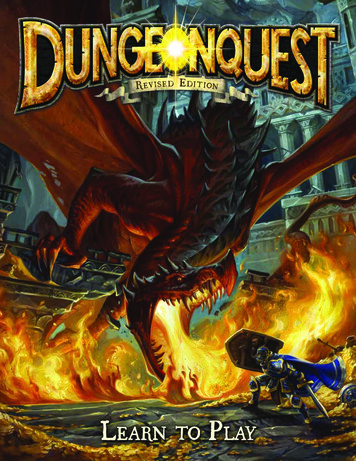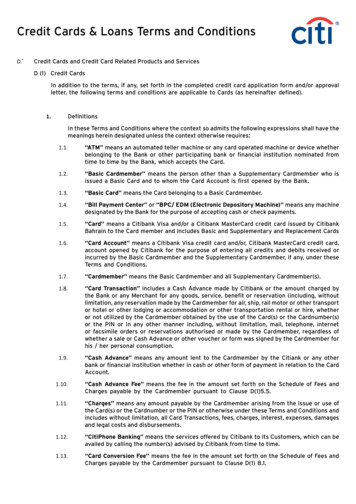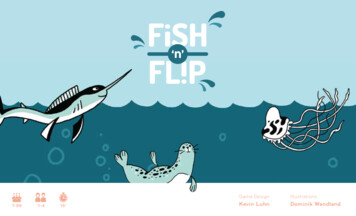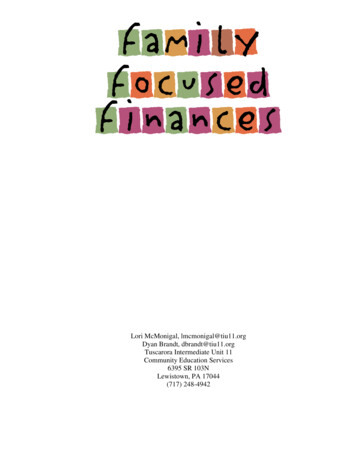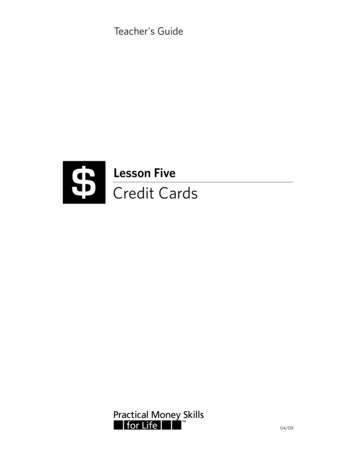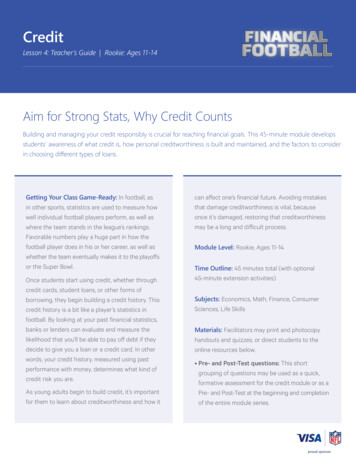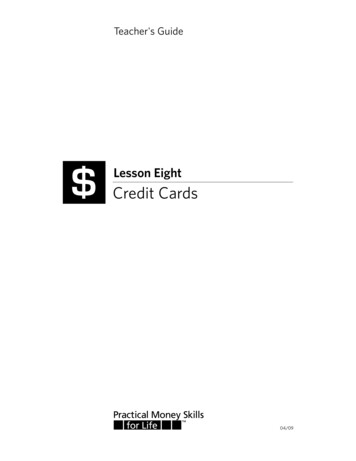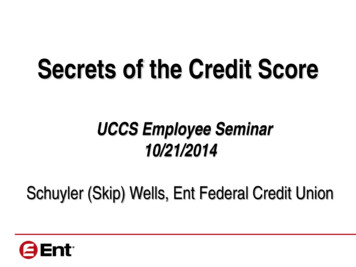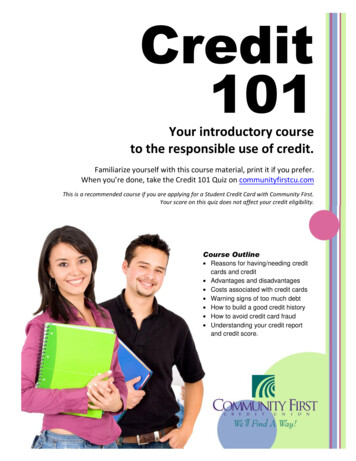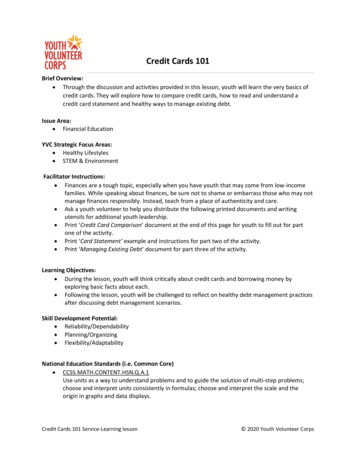
Transcription
Credit Cards 101Brief Overview: Through the discussion and activities provided in this lesson, youth will learn the very basics ofcredit cards. They will explore how to compare credit cards, how to read and understand acredit card statement and healthy ways to manage existing debt.Issue Area: Financial EducationYVC Strategic Focus Areas: Healthy Lifestyles STEM & EnvironmentFacilitator Instructions: Finances are a tough topic, especially when you have youth that may come from low-incomefamilies. While speaking about finances, be sure not to shame or embarrass those who may notmanage finances responsibly. Instead, teach from a place of authenticity and care. Ask a youth volunteer to help you distribute the following printed documents and writingutensils for additional youth leadership. Print ‘Credit Card Comparison’ document at the end of this page for youth to fill out for partone of the activity. Print ‘Card Statement’ example and instructions for part two of the activity. Print ‘Managing Existing Debt’ document for part three of the activity.Learning Objectives: During the lesson, youth will think critically about credit cards and borrowing money byexploring basic facts about each. Following the lesson, youth will be challenged to reflect on healthy debt management practicesafter discussing debt management scenarios.Skill Development Potential: Reliability/Dependability Planning/Organizing Flexibility/AdaptabilityNational Education Standards (i.e. Common Core) CCSS.MATH.CONTENT.HSN.Q.A.1Use units as a way to understand problems and to guide the solution of multi-step problems;choose and interpret units consistently in formulas; choose and interpret the scale and theorigin in graphs and data displays.Credit Cards 101 Service-Learning lesson 2020 Youth Volunteer Corps
CCSS.ELA-LITERACY.CCRA.SL.1Prepare for and participate effectively in a range of conversations and collaborations withdiverse partners, building on others' ideas and expressing their own clearly and persuasively.CCSS.ELA-LITERACY.CCRA.SL.2Integrate and evaluate information presented in diverse media and formats, including visually,quantitatively, and orally.Materials: Credit Card Comparison worksheet and answer keyCard Statement worksheet and instruction keyManaging Existing Debt worksheet and instruction keyWriting utensilsInstructions/Content: Ask the youth what they know about credit cards. How do they work? Is it good to own/not ownone? How do you get one? Read/explain the following: Having credit is having the ability to borrow money. There are a lotof situations that exist when people borrow money. Ask youth if they can name any. Examples include: car loans, student loans, credit cards, andmore. Read: In each case, you’re borrowing money from a lender with a promise to pay it back. And ineach case, credit is all about trust. Every time you borrow money and keep your promise to payit back, you strengthen your ability to borrow again the next time. This is building a good creditrecord, or a good credit history.o Using credit, and credit cards, can help you reach your goals and even help others, butremember: credit cards have benefits and risks. It’s important to use them wisely soyou don’t fall behind and hurt yourself and others in the long run. Part 1: Have students complete the “Credit Card Comparison” activity. After, discuss answers asa collective group. Ask youth if they had to choose a card, which would they pick? Which wouldthey make sure to stay away from? Why/why not? Part 2: Hand out the Card Statement example sheet to youth and have them review it. Gothrough each letter and have youth guess what each section means. Use the “How to Read aCredit Card Statement” sheet for answers, and pass this out to youth after for youth to takehome. Part 3: Pass out the “Managing Existing Debt” document. Read the directions and reassure thatyou don’t have to go into debt if you manage your credit and debt responsibly, but there maycome a time when you feel overwhelmed and want to make some changes. Have youthcomplete worksheet, and share with the group why each strategy should belong in each column.Reflection Activities:Put youth in groups of 2-3 to answer and discuss the following questions.1. How might credit card debt negatively impact individuals and their community?2. Who would you go to if you had a question about money or how to manage it?3. Describe how being responsible with your finances will help others.“Credit Cards 101” Service-Learning lesson 2020 Youth Volunteer Corps
4. What steps can you take now to help you become a responsible credit card holder in thefuture?Career Connections: Credit Card Analyst Financial AdvisorSources: “Citizens Bank & Trust Financial Education Center.” nrollment id king.org%2Fen%2Fresources%2F5 YA About Credit.pdf. “Instructor's Guide.” Hands on Banking, Wells Fargo,handsonbanking.org/en/resources/5 YA About Credit.pdf.“Credit Cards 101” Service-Learning lesson 2020 Youth Volunteer Corps
Credit Card ComparisonDirections: Read through the descriptions of four different credit cards. Fill in the table below to compare the cards.DefinitionsAnnual fee: The fee a credit card company charges a credit card holder to use the card for a year.Annual percentage rate (APR): A measurement used to compare different loans, the APR takes into account aloan’s interest rate, term, and fees to illustrate the total cost of credit expressed as a yearly rate. The lower theAPR, the lower the total cost of the loan/credit line.Rewards: Rewards that a credit card company may offer as an incentive for users to utilize the credit card.Card #1Card #1 as no annual fee, and an initial APR of 0%. The card also includes rewards: with every 1,000spent, you get a 10 gift certificate to a local burger chain. After six months, the APR jumps to 19.1%.Card #2Card #2 also has no annual fee, and an initial APR of 0%. The cardholder can also take money out on thecard at the ATM. However, when these types of transactions are made, the APR jumps to 24.1%. In fact,the rate will go to 24.1% after three months for all purchases, regardless. The card also featuresrewards: after spending 35,000, on the card, you get a free domestic airline flight.Card #3Card #3 also has no annual fee, although the APR is 12.9%, with no different initial APR. No rewards areoffered.Card #4Card #4 is a little different. There is an annual fee of 150, but no APR. With this card, you have to payoff your balance every month. This card also features a reward program: you get one “point” for everydollar spent on the card, and points can be redeemed for magazine subscriptions and other items.Credit CardInitial APR“Credit Cards 101” Service-Learning lessonAPRAnnual FeeRewards 2020 Youth Volunteer Corps
Facilitator Answer Key: Credit Card ComparisonCredit CardInitial APRAPRAnnual FeeRewardsFor every 1,000spent, 10 giftcertificate to localburger chainAfter spending 35,000, freedomestic airlineflightCard #10%19.1% after sixmonths 0Card #20%24.9% after threemonths 0Card #312.9%12.9% 0NoneCard #40%0%, but have to payoff balance everymonth 150A “point” for everydollar spent“Credit Cards 101” Service-Learning lesson 2020 Youth Volunteer Corps
“Credit Cards 101” Service-Learning lesson 2020 Youth Volunteer Corps
How to Read Your Credit Card StatementA. Here is your credit card account number. Remember to keep it a secret! Anyone with access tothis number can use your account.B. This is the closing statement. It’s the date the credit card company created this statement.C. This is amount of your credit line. It is how much money you are limited to spending.D. This is your remaining available credit. It is the amount of credit you haven’t borrowed yet, so itis still available to you.E. In the transaction section, you’ll see a list of each charge and payment you made in the monthshown.F. Your transactions are summarized here, in the account summary section. You’ll also see thetotals for fees and interest charged for this month.G. Here’s the payment information. This shows the total amount you now owe, which is calledyour New Balance.H. This is the minimum payment. Each month, you must pay at least this portion of what you owe.You can pay more than the minimum if you can, or even the full amount. Remember, if youwant to have good credit (and reduce the amount of interest that you will end up paying), it’s agood idea to pay more than the minimum each month.I. This is the due date of the statement. If your credit card company doesn’t receive payment bythis date, they will begin charging you interest on the amount you owe. Most companies willalso charge you a late fee, and/or increase your interest rate.J. In this rate information section, you will see how the interest and fees are being calculatedyear-to-date.K. This is called the payment coupon. It repeats your current payment. You will include this couponwith your check if you choose to pay by mail. If you have moved, you will need to write in yournew address.“Credit Cards 101” Service-Learning lesson 2020 Youth Volunteer Corps
Managing Existing DebtDirections: If the amount you owe others is becoming hard to manage, you are not alone. Millions of people havespent too much credit and learned the hard way how difficult it can be to pay it off. However, it is something youcan learn to work with and overcome if you’re willing to work hard and take important steps. Review the tips andstrategies in the box below, and place each tip below the appropriate column.Positive Debt ManagementNegative Debt ManagementMake more than the minimum monthly payment on credit cardsTake on any new debtHandle it all yourself and don’t tell anyonePay off your highest interest rate debts firstKeep making credit card chargesOpen up new credit cardsMake a written planContact your creditors and ask for a lower rate or different payment schedule“Credit Cards 101” Service-Learning lesson 2020 Youth Volunteer Corps
Managing Existing Debt Facilitator GuideDirections: If the amount you owe others is becoming hard to manage, you are not alone. Millions of people havespent too much credit and learned the hard way how difficult it can be to pay it off. However, it is something youcan learn to work with and overcome if you’re willing to work hard and take important steps. Review the tips andstrategies in the box below, and place each tip below the appropriate column.After youth have filled in the worksheet, go over each answer and discuss why is belongs in its column.Make more than the minimum monthly payment on credit cards – PositiveWhy? You will save a lot of money on interest and reduce or eliminate your debt much sooner.Take on any new debt – NegativeWhy? Say no to additional credit cards or additional mortgages – stop using credit cards altogether. Another creditline means another minimum payment to factor in every month. Increasing your credit cards makes it tougher toreduce your overall debt.Handle it all yourself and don’t tell anyone - NegativeWhy? Many nonprofit debt counseling centers across the country will advise you for a low fee or at no charge (justmake sure to do your research first to determine if it’s real or a scam!) You can also contact the Consumer CreditCounseling Service in your area to help you work out a repayment plan with your creditors.Pay off your highest interest rate debts first – PositiveWhy? To get out of debt rapidly, first pay down the balances of loans or credit cards that charge the highestinterest, while paying at least the minimum due on your other debts. Once the highest interest debt is paid off,start on the next highest, and so on.Keep making credit card charges - NegativeWhy? Continuing to use your credit card while you’re in debt will cancel out any progress you’ve made towardpaying off your debt. If you’re not paying more towards your debt than you’re spending, then the amount you oweis growing instead of shrinking. If you can’t control your credit card habits, cancel them, cut them up , or evenfreeze them in a block of ice!Ignore your credit card bills - NegativeWhy? If only this strategy worked! If you turn your back on your payments, a financial storm is brewing. Minimumpayments are adding up, your balances are growing, and your credit is getting worse every month.Make a written plan - PositiveWhy? Make a list of all bills and the amounts, and review your budget and determine the total amount you canafford to repay each month. Set a date when each bill can be paid. Remember that the more you can pay, thebetter. Determining a solid debt plan will help you achieve your goals and start attacking the problem witheverything you’ve got.Contact your creditors and discuss payment schedules you can afford - PositiveWhy? When you contact your creditors, they will want to work with your to find a payment solution. Try to get alower rate or a different payment plan. Follow through on these commitments by making these new payments ontime, as agreed.“Credit Cards 101” Service-Learning lesson 2020 Youth Volunteer Corps
o Using credit, and credit cards, can help you reach your goals and even help others, but remember: credit cards have benefits and risks. Its important to use them wisely so you dont fall behind and hurt yourself and others in the long run. Part 1: Have students complete the Credit Card Comparison _ activity. After, discuss answers as

